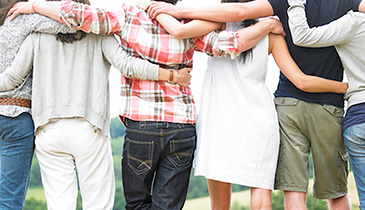 “I have friends who are not so healthy and are always trying to convince me that it’s okay to indulge in chocolate cake or soda or whatever,” writes this week’s House Call. “How can I gracefully handle such situations without coming off like a wet blanket?”
“I have friends who are not so healthy and are always trying to convince me that it’s okay to indulge in chocolate cake or soda or whatever,” writes this week’s House Call. “How can I gracefully handle such situations without coming off like a wet blanket?”
I call these people food pushers, and we all have them in our family, at the office, and within our friend circles.
It can be hard to change your behavior when your friends and family aren’t supportive. When everyone else is doing the wrong thing, it can become a challenge to do the right thing. Eating healthy can feel like a herculean task, but then to have unsupportive people surrounding us makes it even more difficult.
Our social connections are more important than we imagine, considering that you literally become like the people you surround yourself with. Your social circle influences you to some degree; you are more likely to be overweight if your friend’s friend is overweight than if your parents are overweight.
In other words, genetic threads that connect us may be less important than the social threads.
Our social connections and our ancient need to be part of a tribe may be a way out of our epidemic of chronic disease. Some call this “sociogenomics” – how social networks influence health and disease and how social networks alter gene expression – which becomes the overlooked area we need to find a solution for. In fact, there is now a field of social genomics that examines the way in which our social connections affect our gene expression. Our genes are eavesdropping on our relationships.
Sadly, most healthcare programs and doctors completely ignore this crucial connection between the people we surround ourselves with and the influences on our choices and our food quality. In other words, what we eat choose to eat causes disease, and our friends and family determine our food choices.
If social connection becomes the missing link for weight loss and optimal health, how can we more effectively incorporate it into our lives? I found the answer during a trip to Haiti in 2010.
Haiti and the Power of Social Connections
In 2010 I volunteered to help with the aftermath of the earthquake that shook Haiti. My visit was pretty dramatic. I ended up meeting a doctor named Paul Farmer, who successfully treated TB and AIDS – diseases everyone thought were untreatable in places like Haiti, Lima, or Rwanda where extreme poverty exists.
Paul realized we didn’t need a new advance in science or a new medication but something very simple: to rebuild community and connection in broken communities. His genius was his insight that the key to solving insoluble healthcare problems was each other; it was people helping people or what some call peer support.
Paul called it in French “accompaniment”: accompanying each other to health; helping each other build back their communities with clean water, food, going to each other’s houses; and making sure their sick neighbor knew how and when to take their medication.
And it wasn’t just a better delivery model for the right drug or the right information. The community was part of the medicine, part of the cure.
My time in Haiti was brutal, often working 20-hour days amidst amputated limbs and amputated lives, but one of the most enlightening experiences there was working with Paul. I highly recommend you check out his biography Mountains Beyond Mountains.
Talk about harnessing the power of community! Paul literally trained thousands of community workers with what he calls structural violence: the social, political, and economic conditions that drive disease.
Working in Haiti opened my eyes that in the poorest country in the Western Hemisphere, in one of the poorest countries in the world, it wasn’t just infectious diseases that caused devastation. It was also social diseases like diabetes, heart disease, and high blood pressure. Sadly, about 90 percent of these conditions are preventable and often reversible through lifestyle.
Most of these conditions like heart disease, high blood pressure, many cancers, stroke, and even dementia are caused by the same root problem: Diabesity, or the continuum from a little bit of belly fat to pre-diabetes to full-blown Type 2 diabetes.
We know how to prevent, treat, and even reverse diabetes and heart disease, so why don’t we do it? Why have we failed so miserably at this? We have the potential to eradicate the obesity and chronic disease that’s killing most people on the planet, yet we haven’t and the results are disastrous. Consider that:
- – Diabesity will soon affect one in two Americans or literally every other person in America.
- – Full-blown type 2 diabetes affects nearly one in 10 Americans, one in five African-Americans, and one in four Medicare patients.
- – One in three children born today will have type 2 diabetes in their lifetime.
- – About 80 percent of the world’s diabetics are in poor countries
- – One-half of all people with diabetes and almost all of pre-diabetics are not even diagnosed.
Based on those statistics, tackling diabesity might seem overwhelming or too monumental, but I don’t think so. From my perspective, it becomes a small problem that should be addressed locally, with a focus on community and social connection.
We have the solution that can beneficially modulate thousands of genes, enhance the function of dozens of hormones, regulate tens of thousands of protein networks, and prevent, cure, and even reverse most chronic disease. And it works faster, better, and is cheaper than any other drug discovered. It’s available to almost everyone on the planet right now.
That solution is food.
We now know that food is information, not just calories, and that it can upgrade your biologic software. The majority of chronic disease is primarily a food-borne illness. We ate ourselves into this problem, and we have to eat ourselves out of it.
Obesity and diabetes are social diseases. They need a social cure. Think about how many hours you spend every year at the doctor’s office. Probably a few, right? Now, think about how much time you spend in your kitchen, in your schools, in faith-based organizations, at work, where you play. Far more, right?
The reality is, health happens in your community. We have to put people and community, not conventional medicine, at the center of healthcare.
After Haiti I realized that the answer had to be somewhere else. If social networks can promote unhealthy lifestyles, then maybe we can use social networks to create health.
Around that time I read a fascinating book called Turning the World Upside Down about the power of social connections to make change. Clearly, this was a huge topic on my mind.
Then one day a guy walks into my office named Rick Warren, the pastor of the 30,000-strong Saddleback Church in Southern California. “I want to lose weight and get healthy,” he told me. From that desire, thousands of lives were changed.
Over a healthy dinner of beet and cabbage autumn soup and a salad, he described his extraordinarily successful experiment for sustained personal growth and change. Rick had encouraged his congregation to form 5,000 small groups that met every week to study, learn, and grow together in their community. Why not take that same community and encourage people to become healthier?
In that moment, I envisioned using those same small groups as a means of creating healthy lifestyle change. Rick named it “The Daniel Plan,” after the story of Daniel in the Bible, who resisted King Nebuchadnezzar’s temptation of rich food. Daniel and his friends might have formed history’s first support group!
We literally built this program from the ground up. Our goal was to challenge people over six weeks (40 days) of health through the principles of Functional Medicine and social connection.
The results were equally astounding. Warren’s congregations lost a quarter of a million pounds in 10 months. In the bargain, they also improved things like depression, acne, autoimmune disease, and migraines.
Our strategy was revolutionary but simple: Get off the junk and watch everything get better. The congregation put a farm and garden on the church campus. They developed exercise courses. They really committed to transforming their health. Suddenly, the culture changed. It became cool to be healthy rather than joining in on the all-you-can-eat pancake breakfasts!
From that experiment we wrote The Daniel Plan, which was met with rave reviews, numerous awards, and most importantly, a dramatic health revolution that changed the lives of thousands of people.
Co-writing a bestseller was nice, but you know what the real take-home was here? Group support becomes the medicine. Those who used the information but didn’t have a group to connect with lost half as much weight and didn’t get as healthy as those who didn’t. They didn’t do it together.
Social connections are that important.
Creating Community
“Every body needs a buddy,” Rick says. “Getting healthy is a team sport.” I couldn’t agree more. Find a teammate on this journey. Here are a few ways to do that.
- – Don’t go it alone. Enroll your community, health coach, forward-thinking doctor, or a friend to be your teammate on the journey to a healthier you.
- – Find a group of friends to accompany each other to health.
- – Share a meal over an inspired dinner conversation.
The bottom line: Just be there for each other. Support each other.
Everyone’s way of forming social community will be different, but the important thing is that we make it happen. No effort is too small in what I truly believe becomes the missing link for optimal health and wellbeing.




